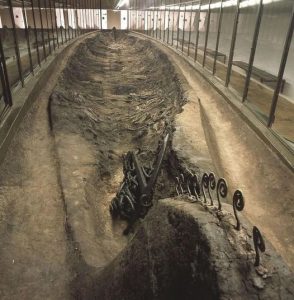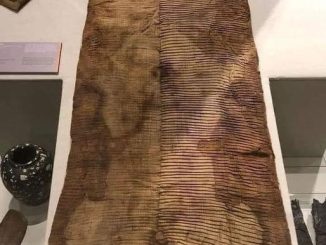Among the significant archaeological finds from the Viking Age, the Oseberg ship burial not only revealed a beautifully crafted ship but also a collection of wooden artifacts, including an exquisite chair made of beech. Discovered in the early 20th century, this chair and other items from the Oseberg burial site provide a fascinating glimpse into Viking life and artistry. These artifacts are currently housed at the Viking Ship Museum in Oslo, attracting scholars and tourists alike.

Historical and Cultural Significance
The Oseberg chair is one of many artifacts unearthed from the famed Oseberg ship burial, which dates back to the early 9th century. The ship and its contents are considered one of the most important discoveries relating to Viking history, offering unprecedented insight into the era’s maritime culture, craftsmanship, and daily life. This particular chair, noted for traces of paint that suggest a colorful past, exemplifies the high level of artistry achieved by Viking craftsmen.
Artistic Details and Preservation
Crafted from beech, the chair’s design and construction reflect the sophisticated woodworking skills of the Vikings. The presence of residual paint highlights the Vikings’ use of vibrant colors, which contradicts the often somber and utilitarian image typically associated with Viking artifacts. However, the chair, like many other wooden objects from the Oseberg find, was preserved using alum, a method initially believed to protect these treasures. Decades later, this preservation technique has posed significant challenges, leading to deterioration issues that threaten the artifact’s longevity.
Conservation Challenges
The alum treatment, while effective in halting immediate decay, has unfortunately initiated a slow process of degradation. Experts at the Viking Ship Museum and other conservationists are now faced with the daunting task of addressing these issues, ensuring that the chair and other artifacts are preserved for future generations. This ongoing conservation effort is crucial in maintaining not only the physical integrity of these artifacts but also their historical significance.
The Chair’s Role in Viking Society
The Oseberg chair, much like other items found within the ship, likely had a ceremonial role, given the context of its burial. The ship burial, which is believed to be a grave for a high-status woman, suggests that the artifacts it contained, including the chair, played a part in ritual and status display. This find challenges some of the traditional views of Viking society, highlighting a sophisticated social structure where art and ceremonial furnishings played a significant role.
The Oseberg chair is more than just an artifact; it is a testament to the artistic prowess and complex society of the Vikings. Displayed alongside the ship from which it came, the chair helps paint a broader picture of life during the Viking Age, marked by rich traditions and advanced craftsmanship. As conservationists work to preserve this invaluable piece of history, the chair continues to be a focal point for understanding the cultural and historical context of one of Scandinavia’s most intriguing eras.








